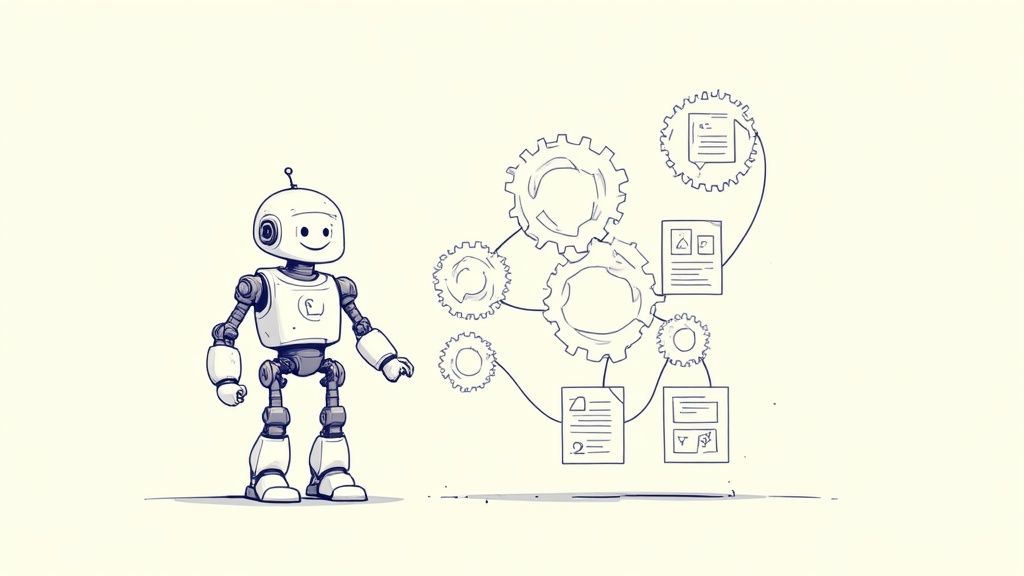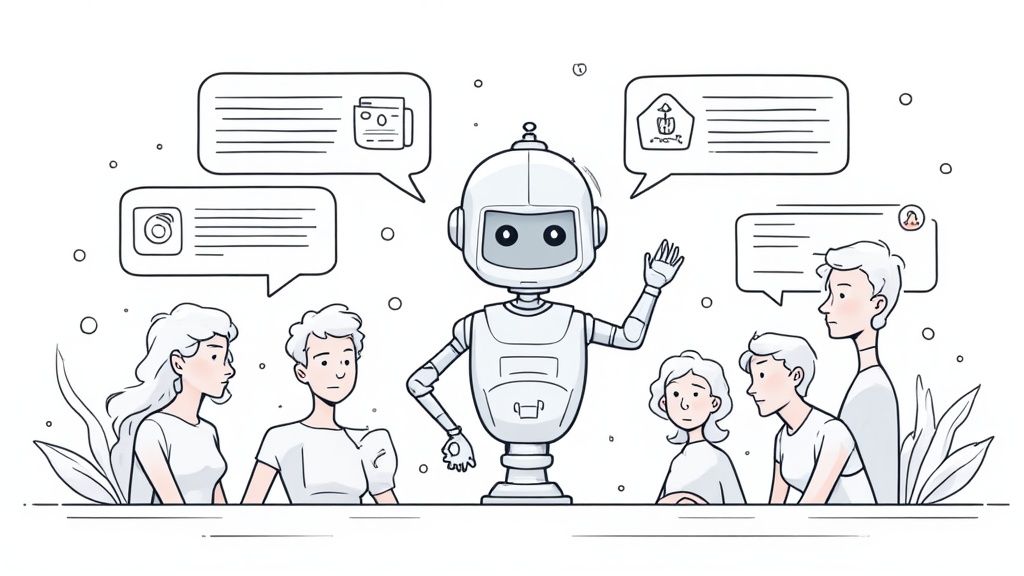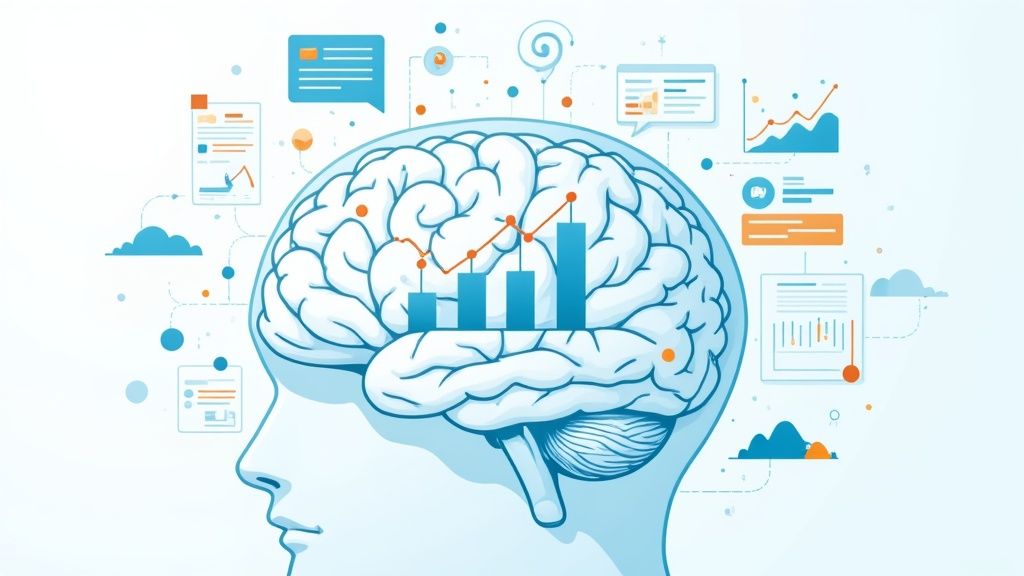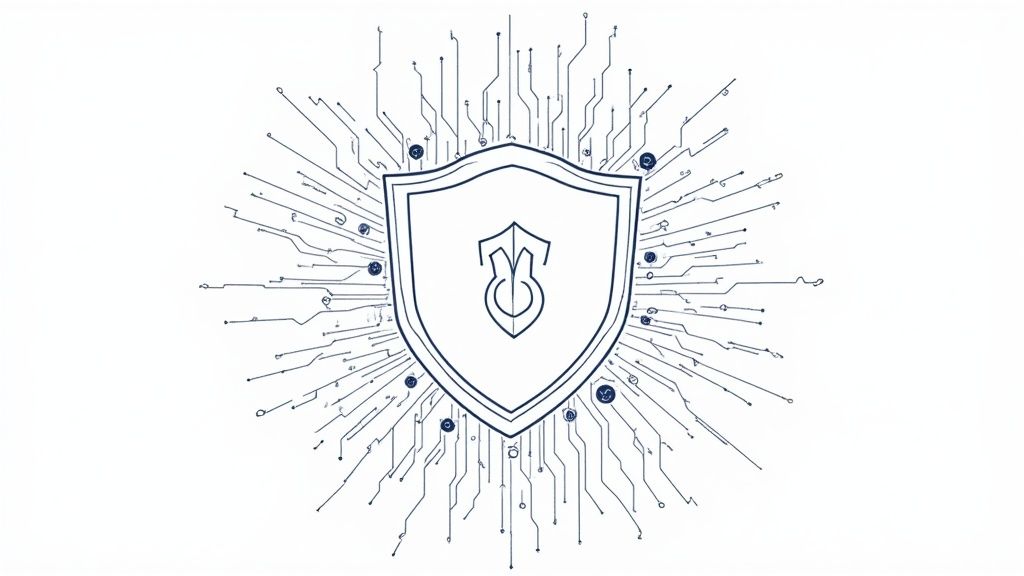Henri Den's Insights on AI for Business
How can AI help your business? If you're a solopreneur, creator, career pivoter, consultant, or purpose-driven professional, this listicle provides eight actionable ways to integrate AI into your operations. Whether you're struggling to differentiate your services, unsure of your content positioning, or seeking more meaning in your work, Henri Den's 27 years of branding and entrepreneurial experience offers valuable insights. Discover how AI can automate tasks, enhance customer experiences, provide business intelligence, fuel innovation, optimize your supply chain, improve marketing and sales, manage human resources, and bolster cybersecurity. This list reveals how AI can propel your business forward.
1. Automating Routine Tasks
One of the most impactful ways AI can revolutionize your business, regardless of its size or industry, is by automating routine tasks. This involves identifying repetitive, rule-based processes that consume significant employee time and resources, then implementing AI-powered systems to handle them automatically. This frees up your human capital to focus on higher-value activities that require creativity, complex problem-solving, strategic thinking, and emotional intelligence – the things AI can't (yet) replicate. Whether you're a solopreneur juggling multiple hats, a growing agency overwhelmed by administrative work, or a consultant managing client communications, AI-powered automation can be a game-changer. By strategically implementing AI, you can streamline operations, boost productivity, and unlock new levels of efficiency. This approach allows your business to operate more efficiently, reduce costs, and ultimately allows you to focus on what truly matters: growing your business and serving your clients.

This method leverages several key AI features: Natural Language Processing (NLP) for tasks like automated email responses and document analysis; Robotic Process Automation (RPA) for streamlining workflows and integrating with existing software; Machine Learning (ML) for adaptive automation that improves over time; API connections for seamless integration with your current business systems; and workflow analysis and optimization tools to identify the best processes to automate. For example, imagine a coach spending hours scheduling client sessions, sending follow-up emails, and generating invoices. AI tools can automate all of these tasks, allowing the coach to dedicate more time to coaching and developing new programs. Similarly, a creator can automate social media posting, content repurposing, and community engagement, freeing up time for content creation and audience interaction.
Examples of Successful Implementation:
- UiPath for JP Morgan Chase: UiPath implemented AI-powered RPA, automating document processing and reducing 360,000 hours of manual work annually. This demonstrates the massive scalability of AI automation for large organizations.
- Blue Prism for Coca-Cola: Blue Prism's "digital workers" automate supply chain documentation at Coca-Cola, showing how AI can streamline even complex, global operations.
- Automation Anywhere for MetLife: Automation Anywhere’s bots process insurance claims at MetLife, reducing processing time by a staggering 93%, highlighting the potential for increased speed and efficiency.
Pros:
- Reduced operational costs: Automation can cut costs by 25-40% by reducing labor expenses and improving efficiency.
- Minimized human error: AI reduces errors associated with manual, repetitive tasks.
- Increased processing speed and throughput: Automated systems can work 24/7, significantly increasing productivity.
- Reallocation of human talent: Employees can focus on more strategic and creative tasks.
- 24/7 operation: AI doesn't need breaks or sleep, ensuring continuous operation.
Cons:
- Initial setup costs: Implementing AI automation can require significant upfront investment.
- Technical expertise: Implementation and maintenance require specialized knowledge.
- Employee resistance: Some employees may fear job displacement.
- Ongoing maintenance: Systems need regular updates to adapt to evolving business processes.
- Limitations with nuanced judgment: AI is not suitable for tasks requiring complex decision-making or emotional intelligence.
Actionable Tips:
- Process audit: Start by identifying high-volume, rule-based tasks suitable for automation.
- ROI calculation: Measure potential time savings and error reduction to justify the investment.
- Phased implementation: Begin with non-critical processes to minimize disruption and refine your approach.
- Center of excellence: Establish a team to govern and manage automation initiatives.
- Regular review: Continuously evaluate and optimize automated processes for maximum effectiveness.
Popularized By: UiPath, Blue Prism, Automation Anywhere, Microsoft Power Automate, IBM Automation.
Automating routine tasks deserves a top spot on this list because it addresses a fundamental challenge faced by businesses of all sizes: doing more with less. By leveraging AI, you can significantly improve efficiency, reduce costs, and empower your team to focus on activities that drive real value for your business. This directly addresses the needs of our target audience, whether it's a solopreneur trying to scale their services, a creator looking to expand their reach, or a career pivoter streamlining their operations. This allows them to focus on their core competencies and achieve greater success.
2. Enhancing Customer Experience with AI
In today's competitive landscape, delivering exceptional customer experiences is paramount to business success. AI offers powerful tools to elevate those experiences, fostering stronger customer relationships and driving growth. This approach leverages AI's ability to analyze vast amounts of customer data, predict future behavior, and personalize interactions at scale. By understanding and anticipating customer needs, businesses can deliver tailored experiences that result in higher satisfaction, increased loyalty, and ultimately, greater lifetime value. How can AI help your business achieve this? By transforming customer interactions through personalized experiences, predictive support, and intelligent engagement across multiple channels.

AI-powered features like chatbots and virtual assistants provide instant, 24/7 support, freeing up human agents to handle more complex issues. Sentiment analysis tools gauge customer feedback from various sources, enabling you to understand customer sentiment and address concerns proactively. Personalization engines analyze customer data to recommend relevant products or services, creating a more tailored and engaging experience. Predictive analytics can anticipate customer needs, allowing you to proactively offer solutions and prevent potential issues. Finally, voice recognition and natural language understanding enable more natural and intuitive interactions with your brand. Learn more about Enhancing Customer Experience with AI
This approach is especially relevant for solopreneurs, aspiring creators, career pivoters, coaches/consultants, and purpose-driven professionals seeking to differentiate themselves and build stronger connections with their target audience. For instance, a coach could use AI to personalize their client onboarding process, providing tailored resources and support based on individual needs. A consultant can leverage AI-powered chatbots to handle initial client inquiries, qualifying leads and scheduling consultations more efficiently.
Examples of Successful Implementation:
- Sephora's Visual Artist AI: Allows customers to virtually try on makeup products, leading to a 30% increase in conversion rates. This demonstrates the power of AI to enhance the customer journey and drive sales.
- Bank of America's virtual assistant Erica: Serves over 19.5 million users and handles over 100 million client requests, showcasing the effectiveness of AI in providing scalable and efficient customer support.
- Starbucks' Deep Brew AI: Personalizes offers to 19 million loyalty program members, resulting in a 10% revenue increase. This exemplifies how AI-driven personalization can boost customer engagement and drive revenue growth.
Pros:
- Provides 24/7 customer support without staffing constraints.
- Delivers consistent service quality across all interactions.
- Enables hyper-personalization at scale.
- Reduces customer service costs while improving satisfaction.
- Captures valuable customer insights automatically.
Cons:
- Risk of impersonal interactions if poorly implemented.
- May struggle with complex or emotionally nuanced situations.
- Requires significant customer data to be effective.
- Privacy concerns with data collection and processing.
- Technology limitations can frustrate customers if not managed.
Actionable Tips:
- Design AI interactions with human handoff options for complex issues: Ensure seamless transitions to human agents when necessary to maintain a personalized touch.
- Start with narrow use cases and expand as you demonstrate success: Begin with a specific area of customer experience and gradually expand your AI implementation as you gain experience and refine your strategy.
- Train AI on your specific customer base and industry terms: Tailor your AI models to your unique audience and industry language for more accurate and relevant interactions.
- Collect feedback to continuously improve AI performance: Regularly gather customer feedback to identify areas for improvement and optimize your AI-powered solutions.
- Balance automation with human touchpoints in the customer journey: While AI can automate many tasks, maintain strategic human interactions to build rapport and foster deeper connections with your customers.
Popularized By:
- Salesforce Einstein
- IBM Watson Assistant
- Google Cloud Contact Center AI
- Amazon Personalize
- Drift Conversational Marketing
By strategically implementing AI and carefully considering the potential challenges, businesses can significantly enhance customer experience, build stronger relationships, and drive sustainable growth. This makes AI-powered customer experience enhancement a vital consideration for any business looking to thrive in the modern market.
3. Predictive Analytics for Business Intelligence
Predictive analytics is a powerful way AI can help your business thrive. It leverages AI algorithms to analyze your historical data, identify recurring patterns, and forecast future outcomes. This empowers you to move beyond reactive decision-making and anticipate market shifts, optimize your operations, and uncover new opportunities before your competitors. In short, predictive analytics gives you a data-driven crystal ball, creating a substantial competitive advantage. This is especially crucial for solopreneurs, aspiring creators, career pivoters, coaches/consultants, and purpose-driven professionals who are seeking to differentiate themselves in a crowded market, refine their content strategy, or simply understand the best path forward.

Imagine knowing which marketing campaign will yield the highest return, or anticipating a shift in customer demand before it happens. This is the power of predictive analytics. Its features include sophisticated machine learning models for pattern recognition, time series forecasting capabilities for projecting future trends, anomaly detection algorithms to identify unusual activity (like fraudulent transactions or sudden drops in engagement), scenario planning tools for evaluating potential outcomes, and interactive dashboards and visualizations for easy-to-understand insights. Learn more about Predictive Analytics for Business Intelligence This empowers you to make informed decisions based on data, rather than gut feeling, a crucial factor for building a successful and sustainable business.
Consider these real-world success stories: Walmart uses predictive analytics to optimize inventory across its vast network of stores, reducing stockouts by 16%. American Express leverages AI-powered predictive models to detect fraudulent transactions with a staggering 99% accuracy. Southwest Airlines utilizes a forecasting system to optimize crew scheduling, saving $100 million annually. These examples highlight the transformative potential of predictive analytics across diverse industries. For a solopreneur, this could mean predicting optimal pricing strategies or identifying the ideal time to launch a new service. For a content creator, it might involve understanding which content resonates most with their audience, allowing them to tailor future posts for maximum engagement.
Pros of Predictive Analytics:
- Improved Forecasting Accuracy: Expect a 20-50% improvement compared to traditional methods.
- Proactive Decision-Making: Anticipate challenges and capitalize on opportunities.
- Uncover Hidden Insights: Identify opportunities and risks that might be missed by human analysis.
- Optimized Resource Allocation: Make data-driven decisions about where to invest your time and resources.
- Competitive Advantage: Gain a significant edge by leveraging data-driven insights.
Cons of Predictive Analytics:
- Data Dependency: Requires clean, comprehensive historical data.
- Bias Potential: Can perpetuate biases present in the training data.
- Model Degradation: Accuracy can suffer if business conditions change significantly.
- Technical Expertise: Needs skilled data scientists for implementation and maintenance (although user-friendly tools are increasingly available).
- "Black Box" Effect: Can sometimes produce recommendations that are difficult to explain.
Tips for Successful Implementation:
- Define Clear Objectives: Start by identifying specific business questions you want to answer.
- Start Simple: Begin with simple models and metrics that deliver quick wins and build from there.
- Combine AI with Human Expertise: Blend AI predictions with your domain expertise for the most accurate and impactful results.
- Regular Retraining: Implement regular model retraining processes to maintain accuracy as business conditions evolve.
- Explainability: Create frameworks to understand and explain AI predictions, building trust in the insights.
Predictive analytics deserves a prominent place on this list because it empowers businesses of all sizes – especially those just starting out – to leverage the power of AI for data-driven decision-making. While there are challenges to overcome, the potential benefits in terms of increased efficiency, improved forecasting, and enhanced competitive advantage are simply too significant to ignore. By following the tips outlined above and understanding both the pros and cons, you can effectively harness the power of predictive analytics to drive your business forward.
4. AI-Powered Product and Service Innovation
In today's rapidly evolving market, staying ahead of the curve is crucial for any business, especially for solopreneurs, aspiring creators, career pivoters, coaches/consultants, and purpose-driven professionals seeking to make their mark. AI-powered product and service innovation offers a powerful way to achieve this, allowing you to develop entirely new offerings or significantly enhance existing ones. This approach leverages AI's ability to analyze vast amounts of data, uncovering hidden customer needs, identifying untapped market gaps, and optimizing designs for maximum impact. This transforms the traditional research and development (R&D) process from a time-consuming, hit-or-miss endeavor into a data-driven, efficient engine for growth. How can AI help your business? By supercharging your innovation pipeline and helping you deliver truly valuable products and services.

AI-driven innovation utilizes several key features to achieve these results. Generative design capabilities can automatically create multiple design options based on specified parameters, drastically accelerating the prototyping phase. Market gap analysis algorithms sift through market data to pinpoint unmet customer needs and identify promising niches. Customer preference modeling uses AI to understand what your target audience truly values, enabling you to tailor your offerings precisely. Furthermore, real-time usage analytics provide continuous feedback, allowing you to optimize your products and services even after launch. This continuous improvement loop is invaluable for staying relevant and adapting to changing market dynamics.
For example, imagine you're a coach struggling to differentiate your services. AI could analyze market data to identify underserved niches within your coaching area, revealing opportunities you might have missed. As a creator, you could use AI to understand what content resonates most with your audience, refining your content strategy and maximizing engagement. Career pivoters can leverage AI to explore new fields and identify skills gaps, guiding their transition into a fulfilling new career.
The benefits of AI-powered innovation are compelling. It can reduce product development cycles by up to 50%, increasing successful product launch rates. It can also uncover non-obvious customer needs and preferences, leading to the creation of truly differentiated offerings that are difficult for competitors to replicate. For a solopreneur, this means a faster time to market and a stronger competitive advantage. For an aspiring creator, it translates to more engaging content and a growing audience.
However, there are also potential drawbacks. This approach requires significant data on customer preferences and behaviors, which can be challenging to acquire, particularly for new businesses. The upfront investment in AI tools and expertise can also be substantial. There's also the risk of over-reliance on AI, potentially stifling human creativity and intuition. It's important to strike a balance, using AI as a powerful tool to augment, not replace, human ingenuity.
Tips for Successful Implementation:
- Combine AI insights with traditional customer research methods: Don't rely solely on AI. Talk to your customers, conduct surveys, and gather qualitative feedback to gain a holistic understanding of their needs.
- Start small and focus on specific problems: Don't try to implement AI across your entire business at once. Identify specific areas where AI can provide the most value and start there.
- Implement rapid testing frameworks for AI-generated concepts: Test your AI-generated ideas quickly and iteratively to validate their market viability and refine your approach.
- Balance technological innovation with customer needs and usability: Don't get so caught up in the technology that you lose sight of the human element. Focus on creating products and services that are both innovative and user-friendly.
By understanding the potential and the limitations of AI-powered innovation, and by following these practical tips, you can leverage this transformative technology to drive growth, create truly valuable offerings, and achieve lasting success in your chosen field. This is why AI-powered product and service innovation deserves a prominent place in your business strategy toolkit.
5. Supply Chain Optimization with AI
One powerful way AI can help your business, particularly if you're involved in product sales or manufacturing, is through supply chain optimization. This application of AI transforms traditional supply chain management by leveraging advanced forecasting, logistics optimization, inventory management, and risk mitigation. This allows businesses, regardless of size, to create more resilient and efficient supply networks capable of adapting to the ever-changing market conditions we face today. This is especially relevant to how AI can help your business thrive in a competitive landscape.
How it Works: AI algorithms analyze vast amounts of historical and real-time data, including sales figures, weather patterns, market trends, and even social media sentiment, to predict future demand with remarkable accuracy. This empowers businesses to optimize inventory levels, avoiding both stockouts and costly overstocking. Furthermore, AI can optimize logistics by planning the most efficient shipping routes, reducing transportation costs and delivery times. By identifying potential disruptions like port closures or political instability, AI also helps mitigate supply chain risks.
Features that Drive Optimization:
- Demand Forecasting Algorithms: Predict future demand with greater accuracy than traditional methods.
- Digital Twin Simulation Capabilities: Create virtual representations of your supply chain to test different scenarios and optimize strategies.
- Autonomous Logistics Planning: Automate route planning and scheduling for optimal efficiency.
- Real-time Inventory Optimization: Dynamically adjust inventory levels based on real-time demand and supply chain conditions.
- Supply Risk Prediction and Mitigation: Identify and mitigate potential disruptions before they impact your business.
Pros:
- Reduces inventory carrying costs by 15-30%: Optimize stock levels to avoid overstocking and minimize storage expenses.
- Decreases transportation and logistics costs by 5-10%: Optimize routes, improve carrier selection, and streamline logistics.
- Improves forecast accuracy by 20-50%: Make better informed decisions based on more accurate predictions.
- Enhances supply chain resilience against disruptions: Proactively identify and mitigate potential risks.
- Enables dynamic responses to changing market conditions: Adapt quickly to fluctuations in demand and supply.
Cons:
- Requires integration across multiple systems and partners: Implementing AI across the entire supply chain can be complex.
- Implementation complexity across global supply networks: Coordinating AI implementation across a global network presents logistical challenges.
- Needs continuous data sharing from partners and suppliers: Data sharing agreements are crucial for success.
- High initial investment for comprehensive implementation: Deploying advanced AI solutions can require significant upfront investment.
- Potential dependency on AI systems for critical decisions: Over-reliance on AI without human oversight can be risky.
Examples of Successful Implementation:
- Amazon: Their AI-driven inventory management system reportedly reduced storage costs by $10 billion while improving product availability.
- Maersk: Implemented predictive analytics for shipping route optimization, leading to a 12% reduction in fuel consumption.
- Unilever: Using digital twins and AI forecasting to reduce inventory by €500 million while improving service levels.
Actionable Tips for Your Business:
- Start with high-impact areas: Focus on areas like demand forecasting or route optimization for initial implementation.
- Build collaborative data-sharing agreements: Secure data sharing agreements with key suppliers and partners.
- Combine AI with Internet of Things (IoT) sensors: Gain real-time visibility into your supply chain operations.
- Develop scenario planning capabilities: Prepare for various disruptions and market changes.
- Train staff to interpret and act on AI-generated recommendations: Empower your team to leverage AI insights effectively.
When and Why to Use This Approach:
Whether you’re a solopreneur selling handcrafted goods online, a growing e-commerce business, or even a consultant managing complex projects, AI-powered supply chain optimization can significantly benefit your operations. If you are struggling with inventory management, experiencing high shipping costs, or finding it difficult to predict demand accurately, AI solutions can offer tangible improvements. Even for service-based businesses, applying these principles to project management and resource allocation can lead to greater efficiency and profitability. This approach deserves a place on this list because it offers a powerful way to leverage AI for increased efficiency, cost savings, and improved resilience, directly impacting your bottom line and allowing you to focus on growth and innovation. Popular platforms providing such solutions include Blue Yonder, o9 Solutions, Kinaxis, SAP Integrated Business Planning, and IBM Sterling Supply Chain Suite.
6. AI-Enhanced Marketing and Sales
Are you a solopreneur struggling to stand out, a creator unsure of your positioning, or a career pivoter needing direction? AI-enhanced marketing and sales can be a game-changer for your business, allowing you to connect with your ideal audience more effectively and achieve significant growth. This application of AI revolutionizes how businesses market and sell their products or services by enabling precise customer targeting, personalized campaigns, automated content creation, and sales process optimization. This directly addresses the challenges faced by our target audience by providing tools and strategies to reach the right people with the right message at the right time, ultimately boosting their success. This is why it deserves a prominent place in this list of how AI can help your business.
How does it work? AI leverages customer data and behavioral insights to deliver personalized experiences across all touchpoints. Think of it as having a tireless virtual assistant that analyzes customer behavior, predicts future actions, and tailors marketing messages for maximum impact. This translates into dramatically increased conversion rates and enhanced customer lifetime value, key factors for any growing business.
Features that power AI-enhanced marketing and sales:
- Predictive lead scoring algorithms: Identify high-potential leads, allowing you to prioritize your sales efforts and avoid wasting time on unlikely conversions. This is invaluable for coaches and consultants looking to attract the right clients.
- Content generation and optimization tools: Overcome writer's block and create compelling content tailored to specific audience segments. Aspiring creators can leverage these tools to refine their content strategy and resonate with their target audience.
- Customer segmentation and targeting capabilities: Divide your audience into specific groups based on demographics, behavior, and preferences. This allows for hyper-personalized marketing campaigns that address individual needs and desires, crucial for service businesses looking to differentiate themselves.
- Next-best-action recommendation engines: Guide your sales and marketing teams with data-driven recommendations on the most effective next steps for each customer interaction. This can significantly improve conversion rates for solopreneurs and career pivoters building new businesses.
- Multi-channel campaign orchestration: Seamlessly manage and optimize marketing campaigns across multiple channels, including email, social media, and paid advertising. This streamlined approach is highly beneficial for busy professionals seeking efficiency.
Pros:
- Increases conversion rates by 30%+ through precise targeting.
- Reduces customer acquisition costs by optimizing channel mix.
- Enables personalization at scale across customer touchpoints.
- Improves sales forecasting accuracy by 25-40%.
- Automates routine marketing tasks, freeing creative resources.
Cons:
- Requires significant customer data to be effective.
- Privacy regulations like GDPR and CCPA may limit data usage.
- AI-generated content may lack human creativity and nuance.
- Risk of over-optimization leading to customer fatigue.
- Technical implementation challenges across marketing stack.
Real-world Examples:
- Spotify: Their AI-driven recommendation engine creates personalized "Discover Weekly" playlists, increasing user engagement by 40%.
- Harley-Davidson: Implementing Albert AI for marketing resulted in a 2,930% increase in leads.
- The Washington Post: Uses Heliograf AI to generate over 850 articles per year, freeing journalists for investigative work.
Actionable Tips:
- Start with enriching customer data and building unified profiles. The more data you have, the more effective your AI-powered marketing will be.
- Implement A/B testing to validate AI-driven recommendations. Continuously test and refine your approach to maximize results.
- Use AI for tactical optimization while maintaining human strategy. AI is a tool, not a replacement for human creativity and strategic thinking.
- Create feedback loops to continuously improve AI marketing models. Regularly evaluate and adjust your AI systems based on performance data.
- Balance personalization with privacy to maintain customer trust. Be transparent with your data usage and respect customer privacy preferences.
Popular Platforms: HubSpot, Salesforce Marketing Cloud, Adobe Sensei, Persado, Albert AI.
By understanding and implementing these strategies, you can leverage the power of AI to significantly enhance your marketing and sales efforts, ultimately driving growth and achieving your business goals. Whether you’re a solopreneur seeking to establish your brand, a creator looking to expand your reach, or a purpose-driven professional seeking more meaningful work, AI-enhanced marketing and sales can provide the tools you need to succeed.
7. Intelligent Human Resource Management
One of the most impactful ways AI can revolutionize your business, especially as it grows, is through intelligent human resource management. This approach leverages the power of artificial intelligence to streamline and enhance virtually every aspect of the HR process, from recruiting and onboarding new talent to developing and retaining existing employees. This is crucial for any business, from solopreneurs looking to scale to established businesses seeking to optimize their workforce. Asking "how can AI help my business?" leads directly to this powerful solution.
Intelligent HR management works by applying AI algorithms to various HR functions. For instance, AI-powered resume screening tools can quickly sift through hundreds of applications to identify the best candidates based on predefined criteria. Sentiment analysis tools can gauge employee morale and engagement, while predictive analytics can forecast potential turnover risks. Personalized learning platforms driven by AI can tailor development programs to individual employee needs and goals.
Here's a breakdown of its key features and benefits:
- Features: Resume screening and candidate matching algorithms, employee sentiment analysis tools, performance prediction capabilities, personalized learning recommendation systems, workforce planning and optimization models.
- Benefits:
- Reduced Time-to-Hire: Streamlined candidate screening can cut hiring time by 30-50%, a major boon for busy entrepreneurs.
- Reduced Bias: AI can help minimize unconscious bias in hiring, leading to a more diverse and inclusive workforce.
- Improved Retention: Early identification of turnover risks allows you to proactively address employee concerns and boost retention.
- Enhanced Skills Development: Personalized learning paths empower employees to develop relevant skills, increasing productivity and job satisfaction.
- Optimized Workforce Planning: AI can help align your workforce with your business needs, ensuring you have the right people in the right roles at the right time.
Several companies have already seen impressive results from implementing AI in HR. IBM's Watson Career Coach provides personalized career guidance to over 30,000 employees, while Unilever has implemented HireVue AI for initial candidate screening, drastically reducing hiring time from four months to just four weeks. Cisco uses predictive analytics to identify employees at risk of leaving with remarkable accuracy (95%). These examples showcase how AI can transform HR, making it more efficient and effective.
Pros and Cons of Intelligent HR Management:
While the advantages are substantial, it's important to acknowledge the potential drawbacks:
Pros:
- Reduces time-to-hire.
- Decreases unconscious bias in hiring processes.
- Improves employee retention.
- Enhances skills development.
- Optimizes workforce allocation.
Cons:
- Potential for algorithmic bias if not carefully designed.
- Employee privacy concerns with monitoring and analytics.
- Risk of dehumanizing HR processes.
- Implementation requires change management.
- May face resistance from traditional HR professionals.
Actionable Tips for Implementation:
- Augmentation, not Replacement: Implement AI as a tool to assist HR professionals, not to replace them. Human oversight and empathy remain crucial.
- Bias Check: Regularly review AI systems for bias and fairness to ensure equitable outcomes.
- Transparency is Key: Be transparent with employees about how AI is used in HR processes to build trust and address privacy concerns.
- Start Small: Begin with narrow applications that demonstrate a clear return on investment (ROI), then gradually expand.
- Human Judgment Matters: Combine AI-driven insights with human judgment, especially for sensitive decisions like promotions or terminations.
When and Why to Use This Approach:
Whether you're a solopreneur just starting out or a consultant with a growing team, intelligent HR management can be a game-changer. If you're struggling to find and retain top talent, experiencing high turnover, or simply want to create a more engaged and productive workforce, AI-powered HR solutions can offer significant benefits. Learn more about Intelligent Human Resource Management
This item deserves a place on this list because it addresses a critical pain point for businesses of all sizes: managing human resources effectively. By automating tedious tasks, providing data-driven insights, and personalizing the employee experience, intelligent HR management empowers businesses to build a stronger, more competitive workforce in today's rapidly evolving market. This directly answers the question of "how can AI help my business?" by offering tangible solutions for optimizing a key area of operations.
8. AI for Cybersecurity and Risk Management
In today's digital landscape, cybersecurity is no longer a luxury, but a necessity for any business, especially for solopreneurs, aspiring creators, career pivoters, coaches/consultants, and purpose-driven professionals who are building their online presence and handling sensitive client data. Asking "how can AI help my business?" inevitably leads to the crucial area of security, and AI offers powerful solutions. AI strengthens your business security posture by proactively detecting threats, preventing breaches, identifying vulnerabilities, and responding to incidents in real-time, often faster and more effectively than traditional methods. This approach leverages machine learning and behavioral analysis to protect your digital assets and sensitive information, all while reducing the operational burden on you or your security team through intelligent automation. This is particularly valuable for smaller businesses or individuals who might not have dedicated security personnel.
How it Works: AI-powered cybersecurity tools learn the normal behavior of your systems and users. By establishing this baseline, they can quickly identify anomalies that might indicate malicious activity. This could range from unusual login attempts and data access patterns to the detection of sophisticated malware. These systems adapt and learn continuously, keeping pace with the ever-evolving threat landscape.
Features and Benefits:
- Anomaly Detection for Threat Identification: AI algorithms can detect subtle deviations from normal behavior that often go unnoticed by traditional security systems, providing an early warning system against emerging threats.
- User and Entity Behavior Analytics (UEBA): UEBA monitors user activity and identifies unusual or risky behaviors, such as a user accessing files they don't normally access, potentially indicating a compromised account.
- Automated Incident Response Capabilities: AI can automate the response to security incidents, containing threats and minimizing damage within seconds, rather than the hours or days it might take with manual intervention.
- Vulnerability Prediction and Prioritization: AI can analyze code and systems to predict potential vulnerabilities before they are exploited, allowing you to prioritize patching and mitigation efforts.
- Adaptive Authentication Systems: AI-driven authentication goes beyond simple passwords, using factors like location, device, and behavior to verify user identity, making it much harder for attackers to gain unauthorized access.
Pros:
- Detects sophisticated threats that traditional systems miss.
- Responds to incidents in seconds rather than hours.
- Reduces false positives by up to 90% compared to rule-based systems.
- Adapts to evolving threat landscapes automatically.
- Alleviates cybersecurity talent shortages through automation, particularly beneficial for smaller businesses.
Cons:
- Potential for adversarial attacks against AI security systems – hackers are constantly developing new techniques to bypass security measures.
- High implementation costs for comprehensive coverage can be a barrier for individuals or small businesses.
- Needs continuous updates to counter new attack vectors.
- Requires significant training data for effective operation.
- May generate alert fatigue if not properly tuned.
Examples of Successful Implementation:
- Darktrace's Enterprise Immune System: This system detects previously unknown threats by learning "self" from the organization's digital environment. They famously detected a potential breach at Drax Power, a major UK energy provider, preventing a significant disruption.
- JPMorgan Chase: Their implementation of AI security reduced false positives by 75% while simultaneously increasing threat detection, freeing up security teams to focus on genuine threats.
- PayPal: Uses AI-powered fraud detection to analyze over 10 million transactions daily, keeping fraud losses below 0.32% of revenue, a critical element for any business processing online payments.
Actionable Tips for Readers:
- Layer AI security with traditional approaches for defense in depth. Don't rely solely on AI; combine it with firewalls, antivirus software, and strong password policies.
- Start with specific high-risk areas like fraud detection or endpoint protection. This allows you to realize the benefits of AI security without needing a complete overhaul of your existing systems.
- Create clear processes for human review of AI security alerts. While AI reduces false positives, human oversight is still essential to validate and prioritize alerts.
- Regularly test AI security systems against new attack patterns. This helps ensure your systems remain effective against the latest threats.
- Ensure compliance with relevant regulations and standards. Data privacy and security regulations are constantly evolving, so stay informed and ensure your security practices are compliant.
Popularized By: Darktrace, CrowdStrike, SentinelOne, Cylance (BlackBerry), Vectra AI
By implementing AI-powered cybersecurity solutions, you can effectively protect your business from increasingly sophisticated threats while freeing up valuable time and resources. This makes AI a powerful ally in answering the question, "How can AI help my business?" especially for those building their presence and businesses online.
8 AI Strategies: Side-by-Side Comparison
| Strategy | Implementation Complexity (🔄) | Resource Requirements (⚡) | Expected Outcomes (📊) | Ideal Use Cases (💡) | Key Advantages (⭐) |
|---|---|---|---|---|---|
| Automating Routine Tasks | Medium-High – requires technical setup | Moderate – initial investment & expertise needed | Increased throughput, cost reductions, minimized errors | Repetitive, rule-based processes | 24/7 operation, reallocation of human talent |
| Enhancing Customer Experience with AI | Medium – configuration of chatbots & analytics | High – extensive customer data & integration | Elevated customer satisfaction and loyalty, reduced costs | Personalized multi-channel customer interactions | Round-the-clock support, consistent quality |
| Predictive Analytics for Business Intelligence | High – needs skilled data scientists & clean data | High – relies on historical datasets and tools | Proactive decision-making, improved forecasting accuracy | Market forecasting, risk identification, scenario planning | Data-driven insights, competitive advantage |
| AI-Powered Product and Service Innovation | High – integration of R&D and AI analytics | High – significant investment in data and design | Accelerated product development and enhanced market fit | R&D, product design, customer trend analysis | Reduced time-to-market, unique differentiation |
| Supply Chain Optimization with AI | High – requires multi-system integration | High – broad integration with partners and systems | Improved logistical efficiency, lower costs, optimized inventory | Logistics, demand forecasting, inventory management | Cost reduction, enhanced resilience, agile adjustments |
| AI-Enhanced Marketing and Sales | Medium – integration into existing marketing stack | Moderate-High – depends on data and channel orchestration | Higher conversion rates, reduced acquisition costs, personalized campaigns | Lead scoring, content optimization, campaign orchestration | Precise targeting, scalable process, automation benefits |
| Intelligent Human Resource Management | Medium – needs change management with tech tools | Moderate – investment in AI recruitment & analytics | Quicker hiring, reduced bias, improved employee retention | Recruitment, workforce planning, performance monitoring | Efficiency in talent acquisition, personalized development |
| AI for Cybersecurity and Risk Management | High – advanced algorithms with continuous updates | High – significant investment in data and monitoring systems | Real-time threat detection, rapid incident response, fewer false positives | Threat identification, vulnerability management, incident response | Adaptive security, reduced manual oversight, robust defense |
Embracing AI for a Brighter Future
As we've explored, the question "how can AI help my business" has many compelling answers. From automating mundane tasks like data entry and email marketing to revolutionizing customer service with AI-powered chatbots and personalized recommendations, the potential of AI to transform your business is vast. We've seen how predictive analytics can provide invaluable business intelligence, while AI-driven product innovation can open doors to entirely new markets. Furthermore, AI can streamline supply chains, optimize marketing and sales strategies, enhance human resource management, and even bolster your cybersecurity defenses. Mastering these AI-powered approaches isn't just about keeping up with the competition; it's about unlocking unprecedented opportunities for efficiency, growth, and ultimately, achieving your business goals. Whether you're a solopreneur seeking to differentiate your services, a content creator refining your brand, or a purpose-driven professional seeking deeper meaning in your work, AI offers the tools to elevate your impact and thrive in the digital age. The future belongs to those who embrace innovation, and AI is at the forefront of that revolution.
Ready to harness the power of AI for your business and navigate the evolving digital landscape? Henri Den provides AI-driven tools and resources to help you implement the strategies discussed in this article, enabling you to optimize your operations, connect with your target audience, and achieve sustainable growth. Explore the possibilities and unlock your full potential with Henri Den.






